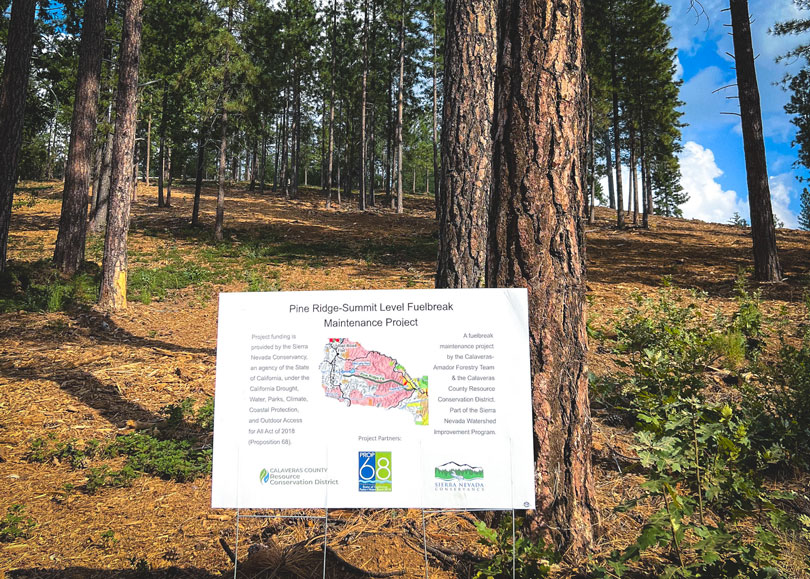
Funded by Proposition 68, the Pine Ridge-Summit Level Fuelbreak is a 150-foot wide, six-mile-long buffer that runs up and along Pine Ridge in Calaveras County to slow wildfires and allow a safer place for firefighters to stop advancing wildfires.
In California, reducing hazardous fuels and constructing strategic fuelbreaks are critical measures to help protect people, homes, communities, and natural resources from damaging wildfires. In Calaveras County, a recently completed project funded by Proposition 68 will do just that, as it widened and reinforced a fuelbreak along a strategic ridgeline to aid in future wildfire suppression and firefighting efforts.
In 2018, California voters passed Proposition 68 (the “Parks, Environment, and Water Bond Act”), which provided $55 million to the Sierra Nevada Conservancy to invest in natural resource conservation and resilience efforts. Just over six years later, most of those projects have been completed, including the fuelbreak now running six miles up and along Pine Ridge in Calaveras County.
“Shaded fuelbreaks thin vegetation so a future wildfire will be slowed and where fire suppression resources can make a stand against an oncoming wildfire,” said Jan Bray, a registered professional forester with the Calaveras-Amador (Cal-Am) Forestry Team, which planned and oversaw the project. “These fuelbreaks are absolutely necessary! Without them, we’d have nowhere to make a stand against large wildfires, which we’ve all learned are extremely devastating to communities, habitat, and infrastructure.”
Key Butte Fire dozer line strengthened, lengthened on strategic ridge
In 2015, the Butte Fire was heading toward Pine Ridge from the northwest. In an effort to help stop the fire from extending past the ridge and into the Calaveras River watershed – and toward several communities, including the town of Railroad Flat – a dozer contingency line was put in place. While the fire, fortunately, didn’t make it to Pine Ridge, CAL FIRE, community members, and local landowners realized the hastily constructed dozer line created an ideal opportunity to create a critical wildfire-resilient buffer.

Strategically located on a ridge that separates two fairly steep watersheds, the Pine Ridge-Summit Fuelbreak provides a nice gap between vegetation to help fight future wildfires.
With the help of a $405,000 grant from the Sierra Nevada Conservancy, the Calaveras County Resource Conservation District and the Cal-Am Forestry Team worked together to expand the Butte Fire contingency line to 150 feet wide and six miles long (144 acres total) – extending it from Railroad Flat Road in the west to Summit Level Road in east.
At the time the grant was being considered, Calaveras County Board of Supervisors, District 2, John “Jack” Garamendi stated his overwhelming support for the project.
“This project reduces hazardous fuels on land that was neglected for years and carries unacceptable loads of surface and ladder fuels,” he said. “In the wake of the most recent wildfires, particularly the 2015 Butte Fire, the Calaveras County Resource Conservation District and the Cal-Am Forestry Team collaborated with local landowners, the Bureau of Land Management, CAL FIRE, the US Forest Service, and more, to restore forest resilience to wildfire, drought, and related epidemics.”
SNC project complements other wildfire-protection work in region
Not only does this strategic fuelbreak provide a key gap in fuel between two steep and forested watersheds to help slow future approaching wildfires from the south or north, but it also combines nicely with other forest-health work in the area, particularly efforts by Sierra Pacific Industries and the Calaveras Healthy Impact Product Solutions (CHIPS), a nonprofit focused on forest restoration and wildfire prevention.
“The Pine Ridge-Summit Fuelbreak project complements other hazard fuel-reduction work CHIPS has performed in the region with funding from the Sierra Nevada Conservancy, including multiple planning and implementation grants for work within the South Fork Mokelumne River watershed,” said Regine Miller, former CHIPS executive director.
Restoring forest health and building resilience to major disturbances, such as wildfire, drought, and insect infestation, especially in a changing climate, are critical throughout California. By reducing heavy fuel loads and installing strategic fuelbreaks between dense forests and steep watersheds, Californians help protect important natural resources, infrastructure, and communities.
“The direct protection this project provides is crucial to the communities and Calaveras River watershed,” said Kaylee Dillashaw, project coordinator with the Calaveras County Resource Conservation District. “I love seeing positive environmental impacts these projects provide, as well as the economic impacts keeping local crews employed out in the woods.”
